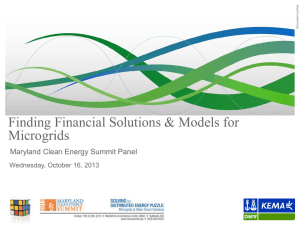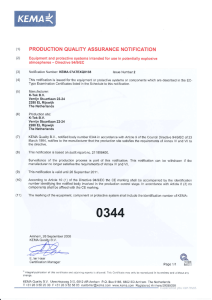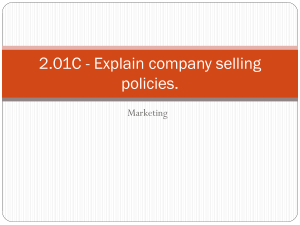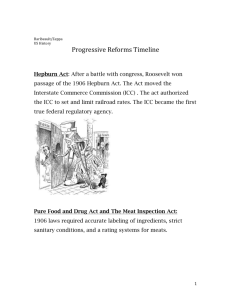memo
advertisement
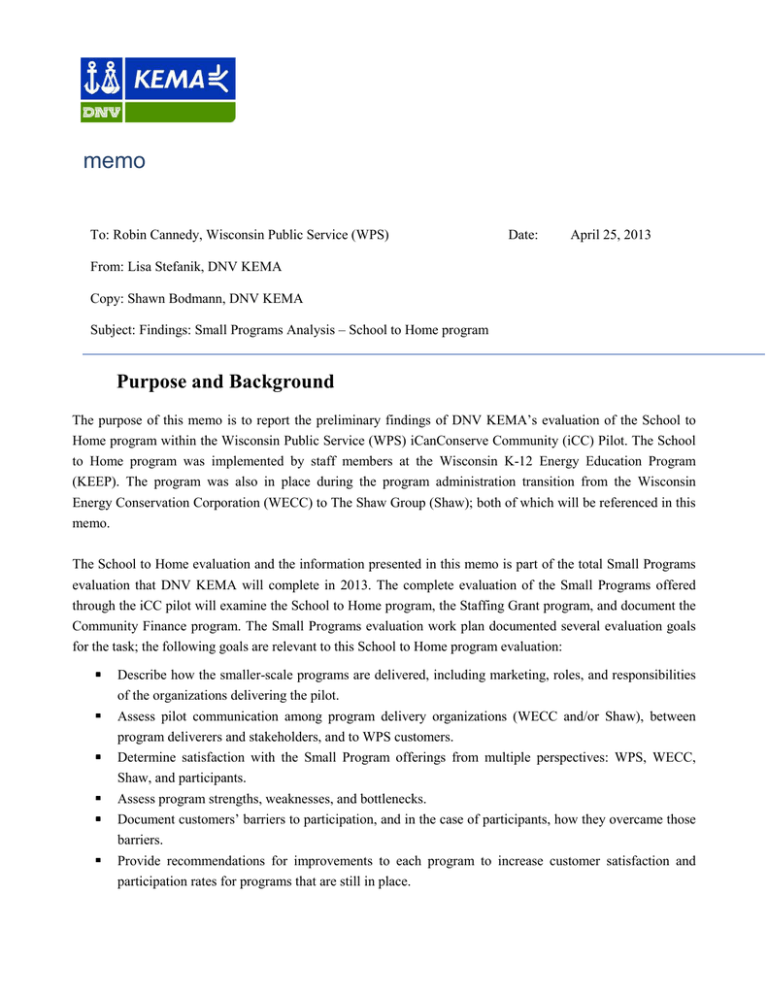
memo To: Robin Cannedy, Wisconsin Public Service (WPS) Date: April 25, 2013 From: Lisa Stefanik, DNV KEMA Copy: Shawn Bodmann, DNV KEMA Subject: Findings: Small Programs Analysis – School to Home program Purpose and Background The purpose of this memo is to report the preliminary findings of DNV KEMA’s evaluation of the School to Home program within the Wisconsin Public Service (WPS) iCanConserve Community (iCC) Pilot. The School to Home program was implemented by staff members at the Wisconsin K-12 Energy Education Program (KEEP). The program was also in place during the program administration transition from the Wisconsin Energy Conservation Corporation (WECC) to The Shaw Group (Shaw); both of which will be referenced in this memo. The School to Home evaluation and the information presented in this memo is part of the total Small Programs evaluation that DNV KEMA will complete in 2013. The complete evaluation of the Small Programs offered through the iCC pilot will examine the School to Home program, the Staffing Grant program, and document the Community Finance program. The Small Programs evaluation work plan documented several evaluation goals for the task; the following goals are relevant to this School to Home program evaluation: Describe how the smaller-scale programs are delivered, including marketing, roles, and responsibilities of the organizations delivering the pilot. Assess pilot communication among program delivery organizations (WECC and/or Shaw), between program deliverers and stakeholders, and to WPS customers. Determine satisfaction with the Small Program offerings from multiple perspectives: WPS, WECC, Shaw, and participants. Assess program strengths, weaknesses, and bottlenecks. Document customers’ barriers to participation, and in the case of participants, how they overcame those barriers. Provide recommendations for improvements to each program to increase customer satisfaction and participation rates for programs that are still in place. Memorandum April 25, 2013 Page 2 Provide a summary of challenges and recommendations for reporting energy savings associated with the School to Home program. Examine the possible correlations between the take home materials and adoption of energy efficient behaviors at home, and investigate available program data tracking mechanisms and files. o Determine if guardians who had a student participate in the School to Home program were more likely to participate in other iCanConserve or Focus on Energy programs. o Determine whether guardians participated in other iCanConserve or Focus on Energy activities prior to their child being exposed through the School to Home program (note: dependent on program participation dates being available in the file). DNV KEMA relied primarily on content from in-depth interviewing of teachers and staff during this evaluation to achieve these evaluation objectives, and completed the following research tasks within this evaluation: In-Depth Staff Interviews of the Wisconsin K-12 Energy Education Program (KEEP) – DNV KEMA carried out two in-depth telephone interviews with KEEP staff members in December, 2012. In-Depth Interviews of participating School to Home Teachers / Administrators – DNV KEMA interviewed six teachers who were familiar with and had recently participated in the School to Home program. We interviewed two teachers from each of the three pilot communities of Brillion, Allouez, and Plover. We also interviewed one principal who played a significant program role within his/her school. Review of Focus on Energy participant tracking data – Shaw provided us data to look for correlations between a household’s participation in the School to Home program and other Focus on Energy programming. Review of program marketing materials and other teacher data collected within the program. DNV KEMA staff reviewed marketing materials shared with us by Shaw, WPS, and KEEP staff. Further, KEEP staff mentioned during their in-depth interviews that they had surveyed a number of teachers who had participated in the program; we reference these data later in this memo. Program Description KEEP implemented the School to Home program. KEEP’s home office is located on the University of Wisconsin-Stevens Point campus, near the third and final iCC pilot community – Plover, Wisconsin. KEEP states on its website that its mission is to “initiate and facilitate the development, dissemination, implementation, and evaluation of energy education programs within Wisconsin schools.”1 They worked as a subcontractor to the Focus on Energy program and to distribute this unique iCC pilot program element in the pilot communities. 1 KEEP Website, “ABOUT” page (as of February 2012): http://www4.uwsp.edu/cnr/wcee/keep/aboutkeep/about.htm Memorandum April 25, 2013 Page 3 The overall goal of the School to Home program was to teach teachers -- and indirectly students -- energy efficiency basics and inspire behavior change that would lead to energy conservation among students’ families. KEEP designed the program to utilize multiple program components to achieve its goals of teaching energy efficiency and influence behavior change. The program was not designed to report or achieve specific energy savings. KEEP created a School to Home Flyer to highlight the various program activities and products available for teachers unfamiliar to the program. The flyer (see Figure 1) summarizes the program offerings: Conservation Kits for 4th grade students (Kit booklets included a Participation Survey) Curriculum integration and consulting sessions with teachers to help them find ways to teach about energy in their curriculum In-class support and guest teaching, where KEEP worked directly in the classrooms and taught energy lessons Home Energy Action Pledges Librarian Resource Grants Free Watt Meters for all teachers who worked with KEEP on School to Home Funding opportunities for energy efficiency and conservation projects within the community LED Holiday Light Exchange. Memorandum April 25, 2013 Page 4 Figure 1: School to Home Flyer, Fall 2012 These various School to Home program activities and services were offered to teachers working in the three iCC pilot communities of Brillion, Allouez, and Plover. KEEP staff interviewed by DNV KEMA reported the School to Home program was slow to start in the iCC community schools. However, they mentioned as they increased their face-to-face contact in the schools, and focused on building relationships (especially with Administrators), the program’s participation numbers built quickly. Cumulative program records provided by the Wisconsin Energy Conservation Corporation (WECC) for this evaluation indicated that 13 unique schools or other Memorandum April 25, 2013 Page 5 educational groups participated within these three communities during the course of the program. Table 1 highlights the participation distribution of teachers across the pilot communities. Table 1: Teacher Participation by Community and Level Community Total (N) Participating Teachers Elementary (N) Teachers Middle School (N) Teachers* High School (N) Teachers* Other Educators (N) (multiple levels or unspecified) Brillion 20 8 4 8 0 Allouez 56 30 NA NA 26 Plover 33 29 NA NA 4 Totals 109 67 4 8 30 *Allouez and Plover do not have elementary level education options in their communities; therefore, data is not expected there. Program Communication DNV KEMA interviewed six teachers and one principal who were listed as School to Home program participants by WECC. For simplicity’s sake throughout the remainder of this report, DNV KEMA will refer to this entire interview group as teachers. The teachers reported hearing about KEEP’s School to Home program in a variety of ways: A direct presentation from KEEP at the school or word of mouth (knowing someone who had participated before) was mentioned most often by teachers. Flyers in their mailboxes were also mentioned. It was clear in our interviews that KEEP’s longer-term presence in the Wisconsin teaching community was also a factor. Some teachers volunteered -- without prompting -- they were aware of KEEP’s forcredit program for teachers2, noting that they had taken it, or planned to take it, in the future. Nearly all interviewed teachers indicated they signed up, and received confirmation of their program enrollment, by e-mail. Teachers that interviewed with DNV KEMA scored their satisfaction with KEEP communication at a 5 (‘very satisfied’) on a five point scale. They appreciated that e-mail communication was both easy and frequent. Two teachers specifically mentioned that KEEP representatives were appropriately persistent with them via e-mail, and this kept them engaged in the program during otherwise busy school times. Multiple teachers mentioned that they especially appreciated KEEP’s clear listing of classroom curriculum options, and their accurate 2 The Wisconsin Center for Environmental Education (WCEE) offers environmental education courses that qualify for Wisconsin continuing education credits for professional development of teachers. KEEP is ultimately a program of WCEE, and KEEP’s specific energy courses count for teacher professional development credit. More information about for-credit opportunities for teachers can be found at KEEP’s professional development section of their web site: http://www4.uwsp.edu/cnr/wcee/keep/ProfessionalDevelopment/index.htm. Memorandum April 25, 2013 Page 6 estimates of how long or involved lessons would be. These teachers regarded KEEP as a reliable partner in their classroom planning and experiences. School to Home Conservation Kits The Conservation Kits – pictured in the Figure 1 flyer earlier in this memo – were among the most tangible – and potentially measureable -- products within the School to Home program. Therefore, DNV KEMA focused on the Conservation Kits distributed to fourth grade students in the iCC schools within this evaluation. The kits contained electric direct install measures and came in a bright yellow bag that students could keep and reuse. The direct install measures in the kit were as follows: two CFL light bulbs (one 14 watt, one 9 watt globe), a shower timer, a smart strip power strip, and a LED nightlight. The kit also contained a booklet. The booklet DNV KEMA reviewed was titled, “2012 Energy Conservation Kit: Fourth graders save BIG”. The booklet was specifically designed for the iCC pilot and printed by WECC. The booklet introduced the kits to the entire family, provided some basic energy information, and led the reader(s) through specific information and activities for each direct install measure. Most of teachers we interviewed taught fourth grade, and received Conservation Kits to distribute to students in addition to the classroom lessons. Two teachers we interviewed only participated with School to Home to integrate classroom energy lessons and/or acquire guest teaching in their classrooms. The teachers who received kits consistently reported during their interviews that the KEEP representative personally delivered the Conservation Kits, eliminating the need for any additional shipping or handling by the teachers. Teachers who could remember the process indicated they worked with KEEP in advance to determine how many kits they needed for their students. All who could recall the process confirmed there were no problems getting enough kits for each student. None of the teachers we interviewed dealt with student non-participation in this program. Conservation Kit Incentives The program offered incentives for both students and teachers who participated in and completed the program. Both KEEP staff and teachers we interviewed mentioned KEEP provided a WATT meter as an added incentive for teachers who participated in the School to Home program. Students who were in classrooms with strong participation survey return rates had the opportunity to earn a pizza party for their class. Some teachers indicated that they held competitions with other schools and/or other classrooms, and the classroom with the highest survey return or completion rate won the pizza party. They hypothesized that the extra level of competition among students drove a higher rate of participant survey returns; compared to if they would have not structured the pizza party incentive competitively. WECC records indicated that 346 “Participation Surveys” were returned by fourth grade students in the three iCC communities by Fall 2012. Memorandum April 25, 2013 Page 7 Conservation Kit: Recent Delivery Changes A few of the teachers DNV KEMA interviewed provided details about recent changes in program delivery. For example, one teacher indicated that during her most recent School to Home unit, KEEP distributed the kits to the students before the lessons with the guest teacher. Previously, a series of guest lectures had come first, and the kits were distributed at the end of guest lecture series. The teacher went on to explain that she thought distributing the kits before the lectures worked better, because the students got to experiment with the equipment and build a common background about energy before the lessons and the unit started. She confirmed that this process change demonstrated KEEP’s program delivery flexibility, and as a result, her students “seemed more engaged.” School to Home Program Impacts This section allows us to revisit two of our key School to Home evaluation objectives presented earlier in this memo: 1) Assessing the satisfaction and the impact of the program on its participants (including teachers), and 2) Examining “the possible correlations between the take home materials and adoption of energy efficient behaviors at home.” Within this memo section, we highlight one finding that was particularly clear within this evaluation: the School to Home program directly impacted the classrooms it ventured into, and teachers reported high levels of satisfaction with School to Home. We also use this memo section to explore the program impacts of the crossmarketing campaigns launched by KEEP during the program, and observe possible correlations between household participation in other iCC or Focus on Energy programs and School to Home program participation. Teacher Satisfaction Teachers reported very high levels of satisfaction with all School to Home program components about which we surveyed. DNV KEMA asked teachers to use a five-point satisfaction scale where 1 was ‘very dissatisfied’ and 5 was ‘very satisfied’ throughout our interviews. We asked them to rate their satisfaction on the following individual program components: their communication with KEEP, the Conservation kits (if applicable), and the program paperwork. DNV KEMA also asked teachers to rate their satisfaction with the program as a whole. Six of the seven teachers DNV KEMA interviewed gave the program as a whole their highest satisfaction rating – a ‘5’ out of ‘5’. The satisfaction categories, and their average rankings, appear in Table 2. Memorandum April 25, 2013 Page 8 Table 2: Teacher Satisfaction by Program Component Satisfaction Measure Average Satisfaction Rating Communication with KEEP Conservation kits Amount of paperwork Program as a whole 4.8 5 5 4.9 DNV KEMA’s panel of satisfaction questions was also often the place within the interview where the teachers voluntarily offered that they were “disappointed that the program is done”, or that they “wished they would do the program again next year”. The teachers clearly reported that they thought the program pieces they received (i.e., curriculum lessons, guest teachers, Conservation Kits, etc) were value-added to their classrooms and students’ experience. DNV KEMA’s evaluation of the School to Home program was not the first time participating teachers were asked about their School to Home program satisfaction. Teacher satisfaction was also the key objective in a brief survey KEEP e-mailed to teachers who had recently completed the program. A copy of KEEP’s survey instrument appears in Appendix A of this document. KEEP shared some of its survey results with DNV KEMA – a small dataset of twenty respondents. Sixteen of 20 teachers rated their program satisfaction at a ‘5’ (most satisfied) – the highest possible satisfaction rating – while the remaining four teachers gave a satisfaction rating of ‘4’. Here were some additional results3 from the KEEP teacher survey: All teacher respondents confirmed the energy education specialist(s) improved upon their energy unit content All teacher respondents affirmed they felt their students benefitted from the iCC School to Home program All teacher respondents indicated they would recommend the program to other teachers. Cross-Marketing KEEP’s School to Home program infiltration and the relationship building they did in schools created an opportunity to do additional cross-promotion of iCC or Focus on Energy programs. DNV KEMA identified three clear connections between KEEP’s presence with the School to Home program and additional outreach to participating families to further their involvement in the iCC pilot program, or specific Focus on Energy programs: 1) The Home Energy Pledge – KEEP staff indicated that when they visited a Wisconsin classroom, they would ask students to confirm what energy efficiency activities they might already do in their home, and families would be asked to make a pledge to make additional energy conservation 3 Note: All of these result statements were from binary ‘Yes/No’ questions. Memorandum April 25, 2013 Page 9 changes. After families returned their pledge form, if their address fell within an eligible area of an iCC community, the pledge would count towards iCC participation, and towards the appropriate Community Reward. KEEP provided pledge forms to students in classrooms they visited in early pilot years; this last (2012) year, they distributed forms more widely at the schools, putting “one in every family folder -not just for the students we worked with.” KEEP felt this augmented strategy widened the exposure of energy efficiency lessons to all students and families in a school, including those KEEP did not have an opportunity to connect with personally in a classroom. Figure 2 shows an example of the Home Energy Activity Pledge form used in Plover. Memorandum April 25, 2013 Page 10 Figure 2: Home Energy Activity Pledge form: Plover 2) The Holiday Lights (LED) Exchange -- KEEP reported that they had a surplus of holiday LED light strings from a previous campaign, and they offered their holiday light surplus to participating iCC schools. Six schools that participated in the School to Home program elected to also participate in the Holiday Lights Exchange. The objective of the Exchange was to encourage community Memorandum April 25, 2013 Page 11 members to bring in incandescent holiday lights and exchange them for LED holiday light strings at no cost. All incandescent lights collected during the campaign were recycled. The schools had program design autonomy, and KEEP confirmed that schools implemented the program in various ways. For example, some schools capped the Exchange at 3 strings per family; others changed out holiday lights for participants on a first come, first served basis with no quantity limit. KEEP reported that some schools tracked participants’ addresses. If the participant was in an iCC community, and hadn’t previously participated in iCC, the participant could be counted towards the Community Reward through the Holiday Light Exchange. The lack of clarity around how each school implemented their particular exchange, and the participation tracking differences from school-to-school, make it extremely difficult to estimate or track energy savings from this particular program. However, KEEP did provide DNV KEMA a record of the number of lighting strings they distributed to the schools. Table 3 presents calculated energy savings estimates for the Holiday LED Light Exchange, assuming all lights distributed to schools were exchanged with customers and put into use. We arrive at these calculations based on estimates for similar technologies in other program jurisdictions. Table 3. LED Lighting Exchange Potential Savings Measure LED Lights - Color LED Lights - Clear Total Estimated Savings Per Unit Deemed Energy Savings (kWh) Number of units Total Estimated Energy Savings 10.6 1,139 12,073 10.6 1,487 2,626 15,762 27,836 3) Home Energy Audit – KEEP aimed to assist WPS in enrolling more iCC community members into a home audit program by distributing the Home Energy Review form in schools where they had a presence. KEEP added their logo to the bottom of all standard applications it shared in schools after the Plover pilot community kick off, which allowed applications that customers obtained through KEEP to later be attributed to the program if a customer moved forward with an audit. Both KEEP and WECC confirmed that 41 of these KEEP-branded Home Energy Review applications were received and processed as a result of this specific marketing effort. The specific marketing examples KEEP produced and distributed through their School to Home program work to promote both the Holiday Lights program and the Home Energy Audit are highlighted in Figure 3 and Figure Memorandum April 25, 2013 Page 12 4, respectively. The red circled KEEP logo in Figure 4 highlights how Focus on Energy was able to link Home Energy Audit activity to a KEEP initiated, School to Home contact opportunity. Figure 3: Holiday Light Exchange Flyer Memorandum April 25, 2013 Page 13 Figure 4: Home Energy Review Flyer* *KEEP staff added logos to all three community pilot handouts at the time the Plover project was kicked off. Memorandum April 25, 2013 Page 14 Conservation Kit Data Collection & Tracking The Conservation kit booklet contained a participation survey which a parent, guardian, or other family member helped the fourth-grader complete. The survey was brief, asking the family to confirm what direct install measures they actually used or installed, and represents an opportunity to measure program impacts. Figure 5: School to Home Participation Survey: Brillion highlights a survey from a Brillion Conservation Kit; a family of a student returning this survey to the classroom counted towards a Community Reward of a solar electric system for the Brillion Public Library. It also asked families to confirm what measure(s) they installed from their kit. Figure 5: School to Home Participation Survey: Brillion The participation survey within the Energy Conservation Kit booklet was a primary data collection tool for the School to Home program. All teachers DNV KEMA interviewed confirmed the students returned their completed participation surveys to them in the classroom. The surveys were picked up by a KEEP representative, and ultimately returned to WECC. DNV KEMA confirmed that these data were not compiled or tracked to verify program savings during its evaluation. We requested the participant survey data as part of our evaluation, and WECC was responsive to this request. Memorandum April 25, 2013 Page 15 Table 4 displays our basic saving calculations based on participant survey data WECC provided from Brillion, Allouez, and Plover. These calculations are not program-specific, as we are using estimates for similar technologies in other program jurisdictions in the table. Therefore, the calculations in this table present the kind of savings the School to Home program MIGHT be able to claim if program tracking was made part of future programming. The estimates in Table 4 suggest that an appropriate estimated savings range for the program’s recent duration could fall between 45,502 kWh and 66,520 kWh. Table 4: School to Home Program: Estimated Conservation Kit Energy Savings (kWh)4 Brillion Allouez Dire ct Install Deemed Estimate d Estimated Measure from Savings* Total N Savings Total N Savings Conservation Kit per unit Installed Range (kWh) Installed Range (kWh) 14 W CFL 39 22-47 858-1,833 88-179 3,432-6,981 9 W CFL 39 17-40 663-1,560 106-148 4,134-5,772 Smart Strip 70.7 25-56 1,768-3,959 144-194 10,181-13,716 Shower Coach Timer NA 31-64 NA 105-207 NA LED Night Light 22 30-64 660-1,408 162-222 3,564-4,884 Total Savings by Community 125-271 3,949-8,760 605-950 21,311-31,353 * Deemed Saving Source: Michigan Energy Measure Database (MEMD) Plover Estimated Total N Savings Installe d Range (kWh) 110-144 4,290-5,616 104-133 4,056-5,187 125-165 8,838-11,666 137-172 NA 139-179 3,058-3,938 615-793 20,242-26,407 Participation in Other Offers Focus staff tracked families who participated in the School to Home program and other iCC offers in its program database. DNV KEMA examined these tracking data to assess the correlation between School to Home and other iCC offer participation. The hypothesis we tried to evaluate was whether School to Home participation encouraged participation in other iCC offers. The results of our analysis are shown in Table 5. Data that were significantly different (90% confidence level) from each other within our comparison groups appear in bold text and yellow fill. These data show that School to Home families were more likely than families who did not experience the School to Home program to take the following actions: School to Home participant families were more likely to get audits in all 3 pilot communities. 4 Data in Table 4 are presented in ranges to represent a) survey data WECC was able to confidently attribute to the iCC pilot program communities, and b) survey data that KEEP compiled independently. WECC staff confirmed their program data totals trended lower because many School-to-Home surveys passed on to them were unreadable or unusable for various reasons. Data from both sources (WECC and KEEP) are displayed in this table to represent an estimated range of possible savings. Memorandum April 25, 2013 Page 16 They were more likely to sign up for rates in Allouez and less likely to opt out of rates in Plover. They were more likely to get Focus rebates in Brillion and Allouez. They were more likely to get tools/tech in Brillion. These data suggest, but do not allow us to conclude with 100% certainty, that the School to Home program was a gateway to other energy efficiency actions or programming for its participants. Table 5: School to Home Participation Only vs. Other Program Participation Community Brillion Allouez Plover School to Home No Yes No Yes No Yes Number of Households 1,375 118 5,324 199 5,048 203 Rate 6% 8% 29%‡ 35%‡ 61%§ 72%§ Participated in Audit Focus 12%* 20%* 22%* 28%* ‡ 14% 20%‡ 19%‡ 25%‡ 15% 6%§ § 14% 12% TT 1%* 3%* 3% 5% 0% 0% Source: iCC Participation Statistics, Shaw Group, Totals through year-end 2012. Brillion (*), Allouez (‡), or Plover (§) School to Home participants are significantly different (90% confidence level) than School to Home non-participants. School to Home Program Evaluation: Summary and Recommendations for Improvements Program Successes Teachers highly valued the School to Home program. Teachers consistently rated the program, KEEP staff, and the program components with high scores throughout our evaluation. Teachers also voluntarily had many positive reviews to share about the program during our in-depth interviews. DNV KEMA found evidence to suggest that the School to Home program led to increased participation in other iCC offers. Schools to Home participants were more likely than non-participants to receive an iCC audit in all three pilot communities. They were more likely to receive Focus on Energy rebates in Brillion and Allouez. They were also more likely to sign up for a pilot rate in Allouez, or remain on a pilot rate in Plover. KEEP’s relationship building with schools overall, and the principals and teachers in the iCC communities, was crucial to program adoption and success. Brillion was the community that had the most time to gain traction with the School to Home program; yet, it had the smallest participation numbers. Memorandum April 25, 2013 Page 17 Relationship building that KEEP staff did in the subsequent community pilot launches raised program awareness, gained teachers’ trust and subsequently boosted participation. Program Challenges KEEP staff reported it was hard to initially gain traction to launch the program in iCC community schools. Both KEEP staff and busy teachers in the iCC pilot schools reported being skeptical of the new program at first. Teachers reported in their interviews there were also uncertain that their partnership with KEEP would be worth the time investment. Program documentation could be more complete. DNV KEMA asked numerous clarifying questions during its program evaluation about how to interpret simple program tracking documents, such as the program participant list by school. For example, when we received that list, we had to ask WECC and KEEP for help determining if the list was for the most recent program activity period (Fall 2012), or whether it was a cumulative participation list since the program’s start. Additional information is needed in the program documentation to create a proper record. Neither KEEP nor WECC compiled data from participant surveys returned by students from the Conservation Kit. The surveys asked families to confirm their installation of direct install measures. Compiling these data as a regular program process would have provided insightful savings numbers in support of a wellregarded program. The School to Home Program largely did not set up their cross-marketing campaigns (e.g., Holiday LED Light Exchange) to include data tracking or reporting. iCC schools had autonomy in how they conducted and tracked the Exchange; therefore, exchange efforts could not be confidently measured, verified, or attributed to the program. Conversely, KEEP’s idea to put their logo at the bottom of the Home Energy Review form starting with the Plover pilot launch was a good example of how simple choices can transfer into robust tracking opportunities. All teachers DNV KEMA interviewed rated the School to Home program paperwork at a ‘5’ because there was not any paperwork. KEEP stated during their interview that they didn’t want to give the teachers paperwork because it “was a conservation program”. However, KEEP likely missed an opportunity to gain additional teacher feedback and / or classroom data which could have been acquired through a small paperwork tradeoff. Recommendations Improve basic program tracking. Create a program record that more clearly defines participation periods, categories, and more. Memorandum April 25, 2013 Page 18 Track and compile program participation survey data in order to estimate program savings and attribute it to the program. The program collected information from families about installed measures, yet did not compile them or explore them further during the program. Estimating the energy savings acquired through the installation of the kit measures could provide valuable program perspective. Better record keeping would facilitate crediting energy savings to the School to Home program. Based on DNV KEMA’s calculations, the program might have been able to claim an estimated minimum of 45,502 kWh savings from the installation of kit measures. Request that participating School to Home Program schools roll out related energy efficiency campaigns (e.g., Holiday LED Light Exchange) in the same way, and track and report results. Campaigns that are set up identically school-to-school, and tracked in a similar fashion, can be evaluated for energy savings. For example, KEEP estimates they distributed 1,487 strings of white lights and 1,139 strings of colored lights during their Exchange campaign in the six schools that opted in. However, DNV KEMA was unable to confirm whether all lights had been exchanged to WPS customers, or the by-school allocation of the lights. Based on our calculations, the program might have been able to claim up to 27,836 kWh of savings for its Holiday LED Lights Exchange with tracking in place. Memorandum April 25, 2013 Page 19 Appendix A: KEEP Teacher Questionnaire
